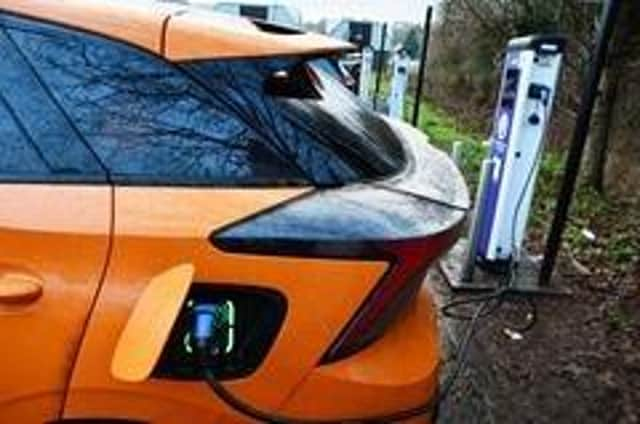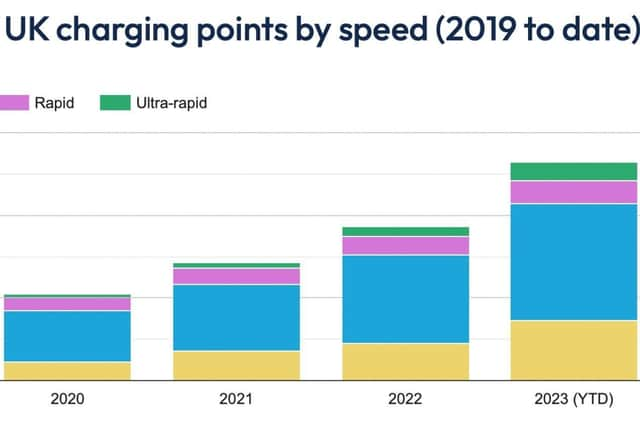More than 400 electric vehicle charge points in Lincolnshire but still below national average
This article contains affiliate links. We may earn a small commission on items purchased through this article, but that does not affect our editorial judgement.


The electric vehicle revolution has been gradually going through the gears, as sales of either battery-powered or hybrid cars rise exponentially and the government pledges to phase out the sale of new petrol and diesel cars in the next 10-15 years.
The number of battery-powered electric cars registered on UK roads has gone up from just over 260,000 to around 1.5 million in less than half a decade. With that came a spike in the new charge points also, a 212% increase in the last four years.
Advertisement
Hide AdAdvertisement
Hide AdLincolnshire County Council unveiled plans to install around 100 new charge points across the county last year, but the process of securing government funding, as well as agreeing to partners who can handle infrastructure of the charging stations, has meant that these are still some way from being delivered.


According to the Department for Transport’s (DfT) most recent data, published in October 2023, Greater Lincolnshire has 414 public charge stations for electric vehicles, which is 35 more than the 379 stated in the DfT’s April report.
Of these 414, just 144 of them are considered rapid or ultra-rapid, due to their minimum 50kw capabilities, which is just under 35% of the charging points in Greater Lincolnshire.
Notably, the area with the most charge points in the county, Lincoln, had no further installs between April and October last year as per the data (remaining on 74), and neither did the local authority with the least, North Kesteven (17).
Advertisement
Hide AdAdvertisement
Hide AdRapid and ultra-rapid charge points can be found in a number of locations across Lincoln, such as at Morrisons on Tritton Road, the Holiday Inn Express car park, and the Lincolnshire Co-op Winning Post food store off Carholme Road.
Elsewhere in Greater Lincolnshire, South Kesteven had the second highest total of charge points with 69, followed by East Lindsey with 66, North Lincolnshire with 49, Boston and North East Lincolnshire with 38 each, South Holland with 35 and West Lindsey with 28.
Population density shows that there are 72.3 charging points available per 100,000 people in Lincoln, the most of any local authority in the county, while North Kesteven is again the lowest with just 14.3 charge spots per 100,000 people.
Lincoln is just shy of the national tally of 73.4 charge points per 100,000 people, meaning that all of Greater Lincolnshire’s local authority areas are below the United Kingdom’s figure by this metric.
Advertisement
Hide AdAdvertisement
Hide AdThis comes after a deal was struck last year by five midlands authorities, fronted by Lincolnshire County Council, to get almost £1 million of government funding for the installation of a further 100 charge points in Lincolnshire.
The county council set an aim of putting all 100 in operation by the end of 2023 — but current findings show that Greater Lincolnshire is 65 shy of its target by January 2024.
Lincolnshire County Council said the process of securing and implementing government funding means it will “take some time yet” before we see tangible infrastructure in terms of electric vehicle chargers, but that surveys and pilot schemes looking at where the charge points would be best suited have proven a success so far.
The tendering process to find who can look after the mechanical aspects of the charging units is underway, but until that is completed the wait for more charge points will go on.
Advertisement
Hide AdAdvertisement
Hide AdCoun Richard Davies, Executive member for Highways and Transport at LCC said: “We are currently deeply involved in the process of getting more EV charging point provision into Lincolnshire. Over the past year we’ve been carrying out a pilot scheme which will deliver a vital plan for what’s best in terms of how we plan to use cars in our county, and get the right hardware provider in place.
“We’ve just completed a county-wide survey that has gathered a lot of information from residents about precisely what they want from EV charging, what their involvement with electric vehicles is likely to be in the future and the more practical views about getting enough charging points in the right places for the benefit of the most people.
“Our efforts so far have secured additional funding from government of £5.6m, which shows a real commitment through the LEVI fund to increase the number of on-street charge points across Lincolnshire.
“It will take some time yet to go through the necessary government funding steps involved before we see infrastructure on the street, but we have already worked through the first stages of a wider EV plan that will eventually see practical answers to the street-charging questions currently raised.”
Advertisement
Hide AdAdvertisement
Hide AdLincolnshire County Council said last year that “the majority” of the chargers would be on-street residential areas, while the rest will go to other council-owned land. The government’s official statistics for charging device grants is due quarterly to corroborate this, but the November 2023 report is yet to be published, meaning the most up-to-date data available only covers up to the end of the 2022 financial year.
For the on-street residential scheme, just eight charge points were installed in Greater Lincolnshire in 2022, and all of those went to North Lincolnshire. Nine were installed in 2021, with eight going to City of Lincoln and another to West Lindsey, while 21 were distributed across the county in 2020 (Boston Borough with 15 and South Kesteven with six).
In financial terms, City of Lincoln Council’s eight on-street residential installations worked out at a government grant value of £52,779, while the eight given to North Lincolnshire Council in 2022 totalled a grant of £94,946, West Lindsey’s one charger in 2021 was worth £6,065 of grant funding, Boston Borough’s 15 installations in 2020 came from a pot of £41,641, and South Kesteven’s six were made possible by the awarding of £43,343.
As for approved applications for further proposed charging devices, the government data finds that Lincoln was granted funding for 25 more charging devices for the 2023 financial year — while there were 20 for East Lindsey and 35 for North Lincolnshire.
Advertisement
Hide AdAdvertisement
Hide AdThis works out at an eligible £187,500 for Lincoln’s charge points, £98,300 for North Lincolnshire’s and £150,000 for the 20 in East Lindsey.
The Institute of the Motor Industry reported last year that nowhere in Greater Lincolnshire has even five per cent of its technicians qualified to work on electric vehicles, which highlights another challenge in transitioning to a plug-in vehicle future, alongside the infrastructure needs for installing charge points.
British automotive service company the RAC has criticised the government on its lack of action regarding the installation of electric vehicle charging points, after it conducted research to show that just 36% of motorway services have at least six rapid or ultra-rapid charging points — despite a government pledge for all motorway services to have six or more by the end of 2023.
One of those motorway services to have multiple rapid charging points is Grantham North on the A1, which has 15 devices and 23 connectors in total, all but one of which is at least 50kw.
Data from ZapMap shows that there were 53,029 electric vehicle charging points across the UK as of November 2023, for around 1.5 million registered plug-in cars on our nation’s roads, whether they are hybrid models or battery-electric.
Advertisement
Hide AdAdvertisement
Hide AdThe race is on to ensure charge point installation keeps pace with the number of electric vehicles registered for road use. In 2019 there were 16,965 charge points in the UK, and as of November 2023 there were 52,933 — translating to a 212% increase in four years.
Comparatively, battery-electric cars have grown exponentially in popularity. A near-tenfold increase in cumulative battery-electric cars in the UK from 2019 to November 2023 highlights the demand, as does the steep jump from 264,000 EV cars in 2019 to 1.5 million in 2023.
The government expects a minimum of almost 300,000 electric vehicle charge points in the country by 2030, as it seeks to shrink this gap between the production and registering of plug-in cars and accessible spots to charge them.
While time might be of the essence when it comes to this subject, the government has given itself an extra five years by pushing back its proposed ban on the sale of new petrol and diesel cars to 2035. Research in Startline’s November Used Car Tracker shows that 16% of motorists — almost one in six — feel the delay of this ban will decrease the likelihood of their next car being electric-powered.
Advertisement
Hide AdAdvertisement
Hide AdHowever, the DfT has unveiled new rules requiring car manufacturers to sell a minimum proportion of zero-emission cars, with the threshold being 22% of all cars sold in the UK by an individual manufacturer needing to be zero-emission. This became law on Wednesday, January 3 and will rise annually until it reaches 100% by 2035 — in line with the new petrol and diesel cars sales ban.